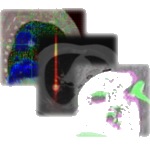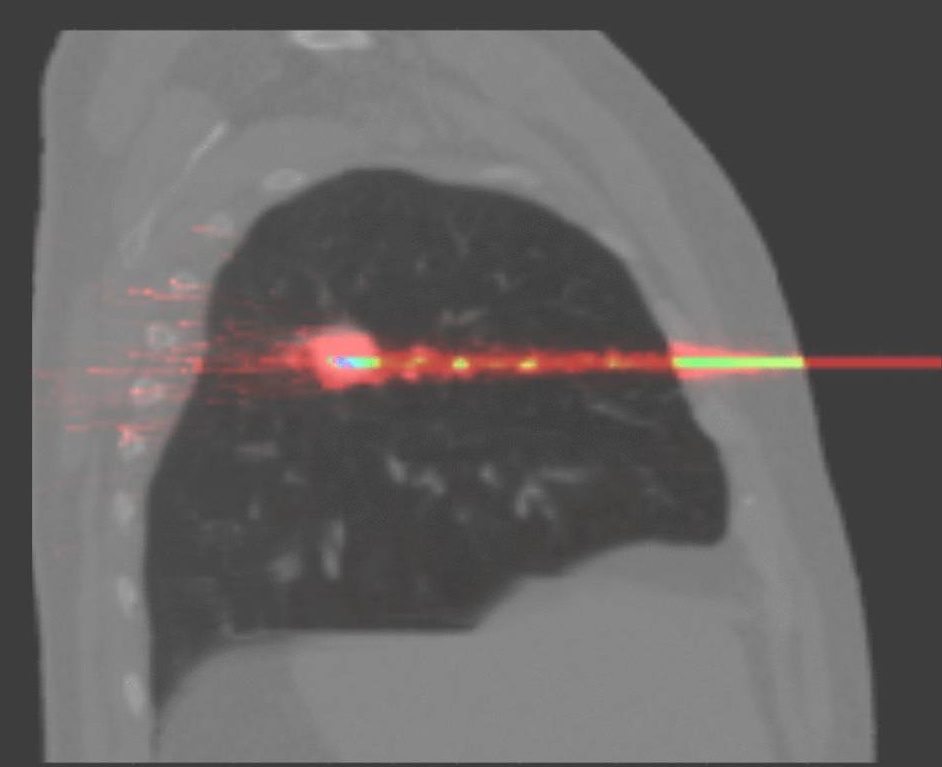Activities
New radiotherapy techniques such as ion beam therapy improve patient-specific treatments with a better conformation to the target and less dose to organs at risk. These improvements can enable new treatment strategies, e.g., hypo-fractionated radiotherapy. They also give rise to several major challenges, among which the fast and accurate calculation of the biological dose (required for treatment planning) and precise advanced image guiding techniques (for planning, patient positioning, and online treatment monitoring). Our activity is concentrated on two axes:
- Simulation for treatment planning, monitoring and imaging in radiation therapy, with a focus on ion beam therapy and Monte-Carlo simulation,
- Image-guided radiation therapy (IGRT), with a focus on lung, prostate and liver cancers.
Our publications can be found here, here, here and here.
Simulations in radiation therapy
Simulation for ion beam therapy: Our aim is to develop a reference simulation platform within the OpenGate international collaboration, based on the Gate/Geant4 Monte Carlo code, and to address several important research issues raised by ion beam therapy:
- Accurate calculation of the biological dose based on a realistic description of the radiation quality in highly heterogeneous media (CT patient description)
- Inverse planning in intensity modulated particle therapy (requires fast dose calculation)
- Prediction of the secondary radiation detectable outside the patient during the treatment for in vivo online monitoring (required for developing online monitoring systems).
Although some expertise already exists in Germany and Japan as regards the two first issues, the field is still very far from being thoroughly explored. The last issue is almost completely new. Our strength lies in our experience with several complementary algorithmic approaches: analytical (fast), Monte Carlo (detailed and accurate but slow) and hybrid (an original concept consisting in combining the advantages of analytical and Monte Carlo calculations). We are involved in several projects related to this research axis: PARTNER and ENVISION (FP7), GAMHADRON, HGATE and PROUESSE (ANR).
Image-guided Radiation Therapy
Image-guided radiotherapy is a research axis pursued in strong collaboration with physicians and medical physicists of the radiotherapy department at the Léon Bérard cancer center (CLB). Our current projects are:
- Clinical implementation of deformable image registration for the evaluation of the MidP treatment planning strategy in a clinical study (in partnership with Elekta and in the context of the LYRIC project);
- Ion beam guided therapy with surface scanners (ULICE european project);
- Ultrasound IGRT of the prostate (in partnership with Elekta);
- Improvement of cone-beam CT image quality for in-room IGRT in parnership with the Université Catholique de Louvain and the company IBA (project ImagX);
- Image guidance of High Intensity Focused Ultrasound (HIFU) treatments of liver cancer (in the context of the LYRIC project).
On-going research projects
- Marie-Curie fellowship on proton CT and cone beam CT reconstruction
- Research project funded by the Fondation pour la Recherche Médicale on computational methods to optimize proton radiography and tomography for improved proton therapy
Developed Open-Source software
 | VV (vv.creatis.insa-lyon.fr) is an open-source and cross-platform image viewer, designed for fast and simple spatio-temporal images visualization : 2D, 2D+t, 3D and 3D+t (or 4D) images. It is more specifically designed for qualitative evaluation of images registration and deformation field visualization. It also contains several tools for comparing images using transparency or fusion, visualizing vector fields and defining landmarks. |
 | GATE : is a software for Monte-Carlo simulation in nuclear imaging, based on Geant4 and developed in international collaboration OpenGate. Our contribution consists in extending the application field of GATE to radiotherapy and hadrontherapy. |
 | GateLab : the GateLab is an end-user application allowing researchers to easily execute GATE on a computing grid (EGEE). It consists of a web server based on Moteur and of a Java client using VBrowser as GUI for the logic catalog (LFC) of the EGEE grid. |
 | RTK : the objective of this project is to develop a toolkit for fast tomographic reconstruction compatible with ITK. |
Platform
The research actions are based on two main collaborative institutes:
- the radiation therapy department of the Léon Bérard cancer center located in Lyon (6 LINAC, 4D CT, CT-PET, 6 DOF robotic table, video system for patient positioning).
- the ESRF (European Synchrotron Radiation Facility) in Grenoble with Synchrotron Radiation micro-CT device (beamline ID19)

